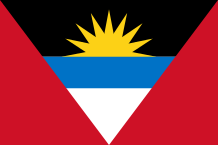ANTIGUA & BARBUDA
 Antigua’s land area is 280 sq km. Its highest point, located extremely southwest is the Mount Obama (formely Boggy Peak) that reachs 402 m (1319 ft). Situated in 40 km in the north of Antigua, Barbuda, has a flat relief and its area is 161 sq km ; its highest mount is 44 m.
Antigua’s land area is 280 sq km. Its highest point, located extremely southwest is the Mount Obama (formely Boggy Peak) that reachs 402 m (1319 ft). Situated in 40 km in the north of Antigua, Barbuda, has a flat relief and its area is 161 sq km ; its highest mount is 44 m.
Although deforested during the period of colonization, Antigua’s vegetation consists of gigantic bamboos, mahoganies, lianas, orchids and creepers in the rain forest, locust trees, ficus, succulents and agaves on the coast and mangroves in lagoons. The island has many salty ponds and swanps which attract stilts, egrets or pelicans. In this land also lives one of the two rarest snakes of the world – the harmless Antiguan racer – which only leaves its refuge in the late afternoon when the temperature falls but it is almost impossible to see.
The lagoon of Barbuda is populated with the more important colony of frigates in the Lesser Antilles. It is a tourist spot.
From the 1960s, both islands gave up gradually agriculture. Tourism and finance became the main branches of industry ; fishing and farming represent only 10% of the economy.
Antigua’s first inhabitants were the Ciboneyes ; their stone tools and shell crafts were found in a dozen sites. They came probably from South America towards 2000 BC, followed (35-1100 BC) by the Arawak tribe. Peace-loving by nature, they settled on the coasts where they fished and grew corn and manioc. They also were talented ceramists, the archaeologists found everywhere in the Caribbean ceramic ustensils (bowls, jars etc.). Towards 1200 AD, another people come from Amazonia and very warlike – the Caribs – invaded the lands occupied by the Arawaks.
Christopher Columbus discovered the island in 1493 during his second voyage in the West Indies, but he did not go ashore and named it Antigua in honour of Santa Maria de la Antigua, the Virgin he adored in Sevilla (Spain).
In 1632, the British colonists decided to settle in Antigua. They grew tabacco and indigo. In 1684, arrived on the island Sir Christopher Codrington who established the first sugar cane plantation, called Betty Hope. War broke out between Carib warriors and English soldiers. At the end of the 17th century, the import of African slaves began in order to increase the production of sugar.
Fifteen years later, this growing wad spread and, in the middle of the 18th century, there were in Antigua more than 150 windmills to grind the cane. Today, about a hundred of these structures in stone survives but they are transformed into houses, restaurants, bars or stores. Thanks to this growing the island got rich, the English settlers built numerous fortifications to protect themselves.
At the end of the 18th century, Antigua became a strategic port allowing to control sea routes towards the rich colonies.
On the island was constructed the most powerful British naval base in the Caribbean, its most famous admiral was Horacio Nelson.
The island stayed under British rule, except in 1666 when the French seized it but the next year, it returned to Great Britain by the treaty of Bredes
The Abolition of slavery (1834) and the refined beetroot sugar caused the bankruptcy of the plantations.
In 1967, both islands got more autonomy. On November 1, 1981, Antigua and Barbuda became an independent State ; England is in charge of foreign politics and defense. The country is led by a Prime Minister and belongs to the Commonwealth.
Area : Antigua : 280 sq km (108 sq miles) / Barbuda : 161 sq km (62 sq miles)
Population : 92 000 inhabitants
Capital : St John’s (on Antigua) / Codrington (Barbuda)
Language : English
Currency : Eastern Caribbean Dollar (EC$)
People : Antiguans / Barbudans
